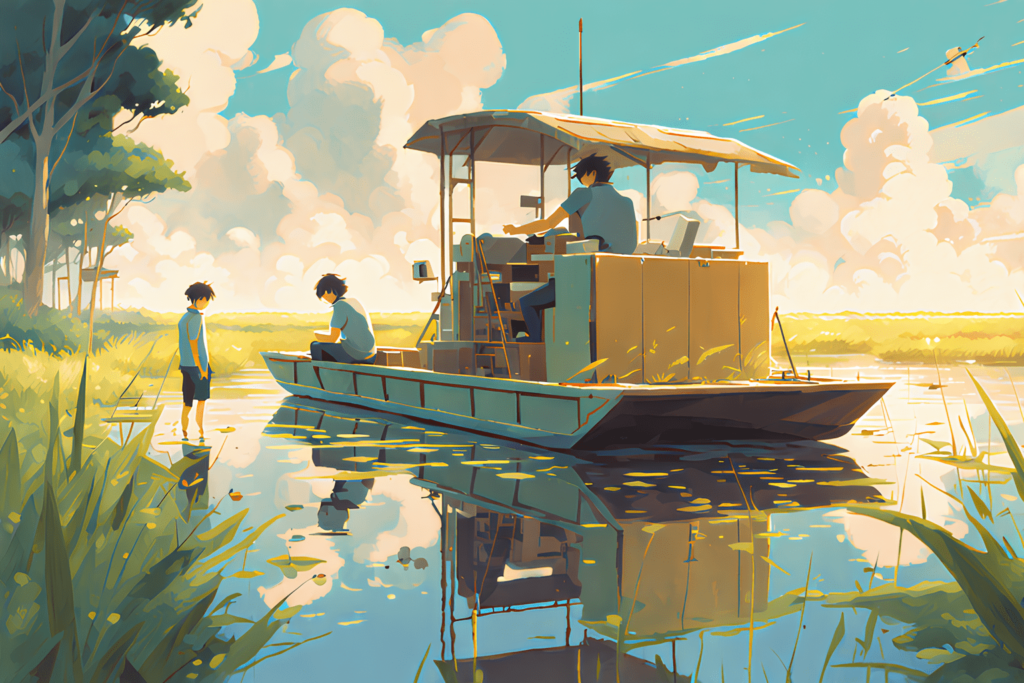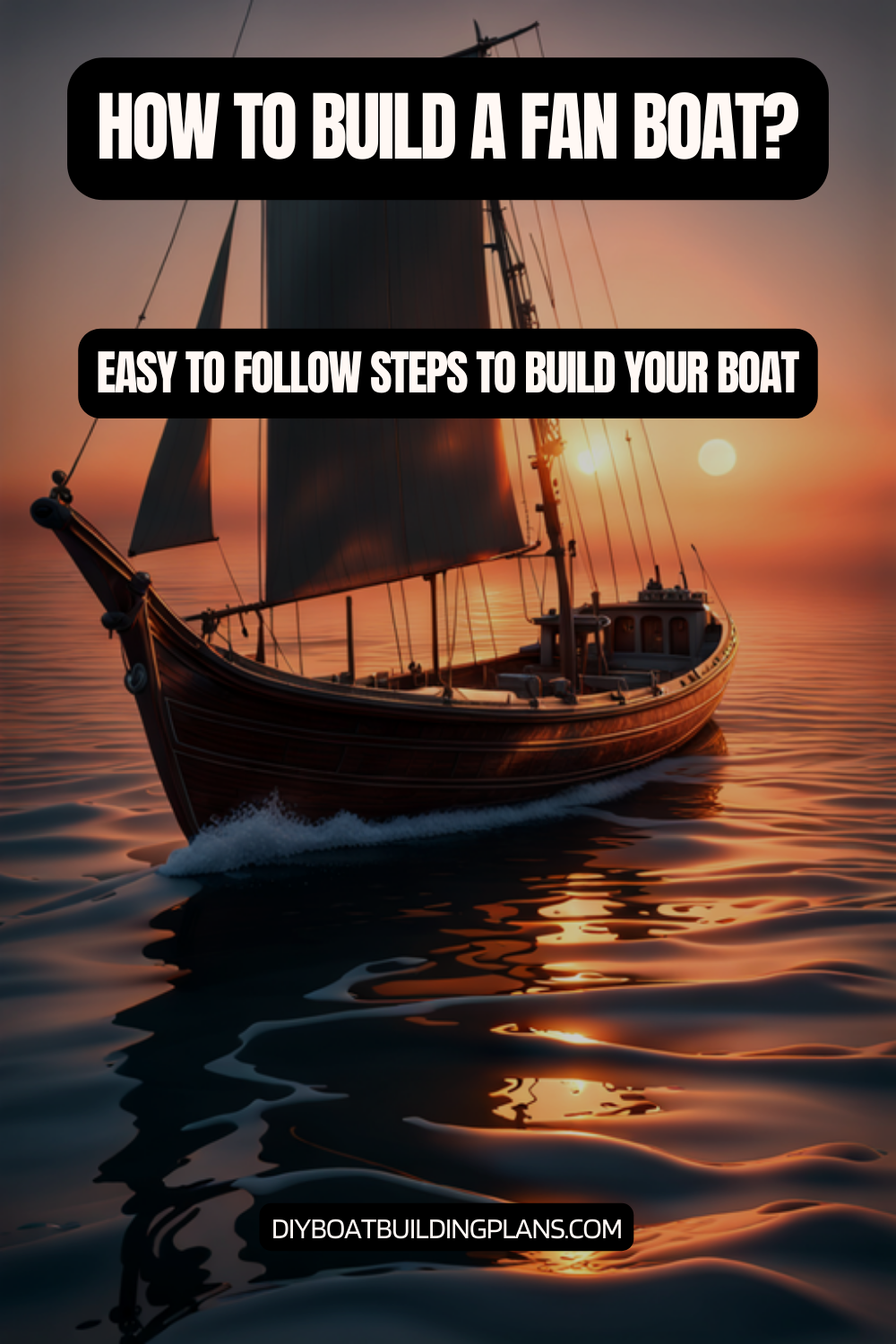Ever thought about turning simple materials into a cool watercraft? A homemade fan boat is more than a weekend project—it’s an adventure!
DIY fan boat fans know it’s a mix of creativity, engineering, and fun. With just $60 and basic tools, you can make a unique boat for hours of fun.
This guide will show you how to make a fan boat from everyday stuff. It’s perfect for hobbyists or water sports lovers. Building a fan boat is a fun challenge that tests your skills and lets you explore the outdoors.
Key Takeaways – How To Build a Fan Boat
- Total project cost is approximately $60
- Battery life exceeds 30 minutes per charge
- Homemade fan boats are highly maneuverable
- Basic technical skills are sufficient for construction
- No specialized marine engineering experience required

Introduction to Fan Boats
Fan boats are an exciting DIY watercraft that mix engineering with outdoor fun. They let people build something special and explore waterways with their own machine.
Learning about fan boats shows a cool design that’s both useful and fun. Unlike regular boats, fan boats have a big propeller at the back. This makes them great for different water places.
What is a Fan Boat?
A fan boat is a flat-bottomed boat that moves with a fan system. These boats can move easily over water, marsh, and shallow areas. They started from airboat designs for swampy areas and now are fun DIY projects for water lovers.
Benefits of Building Your Own Fan Boat
- Save a lot of money compared to buying a commercial boat
- Make it exactly how you want it
- Learn a lot about engineering and mechanics
- Have a boat that fits your needs perfectly
Tools and Materials Needed
Knowing what materials you need is key for a good fan boat project. Here’s a list of important parts:
| Category | Required Materials | Estimated Cost |
|---|---|---|
| Hull Construction | Marine-grade plywood, styrofoam | $150-$250 |
| Propulsion System | Motor, propeller, ESC | $200-$400 |
| Control Mechanisms | Transmitter, receiver, servo | $100-$200 |
“Building your own fan boat is more than a project—it’s an adventure in engineering and creativity.” – DIY Watercraft Enthuasiast
Building a DIY fan boat is more than just a project. It’s a chance to learn and feel proud of what you’ve made.
Designing Your Fan Boat
Creating the perfect fan boat starts with a good design. It’s all about planning, knowing the right dimensions, and understanding aerodynamics. A well-designed boat will give you the best experience on the water.
Choosing the Right Dimensions
The size of your fan boat is key to its performance. Think about these important factors:
- Water environment (lakes, marshes, rivers)
- Intended use (recreation, fishing, exploration)
- Available storage space
- Transportation capabilities
A typical fan boat is 14-20 feet long. For beginners, a 16-foot design is a great choice. It’s both easy to maneuver and stable.
Sketching Your Design
To bring your fan boat design to life, start with detailed sketches. Begin with drawings that show:
- Hull shape and contours
- Seating arrangement
- Motor and fan placement
- Storage compartments
“A well-designed sketch is the blueprint of your future adventure” – Experienced Boat Builder
Considering Aerodynamics
Aerodynamics are vital for your fan boat’s performance. A sleek design cuts through air and water, reducing drag. Aim for a smooth, sloped front.
Important aerodynamic tips include:
- Minimizing sharp edges
- Creating a gradual hull slope
- Reducing weight where possible
- Ensuring balanced weight distribution
By focusing on design, dimensions, and aerodynamics, you’ll make a boat that excels in different waters.
Unlock the secrets to building your dream boat with MyBoatPlans! With detailed plans for over 518 boats and expert video tutorials, you’ll have everything you need to create your perfect vessel. Click here to begin your journey!
Selecting the Right Motor
Choosing the perfect fan boat motor is key for great performance and fun. The right engine can make your DIY project shine, affecting speed and how easy it is to maneuver.
Fan boat motors vary in type and power. Knowing what power you need is vital for a reliable and efficient boat.
Types of Motors for Fan Boats
- Electric motors (2.5 HP to 50 HP)
- Gasoline outboard motors (40 HP to 350 HP)
- Marine inboard engines (135 HP to 1000 HP)
- Two-stroke and four-stroke engine designs
Power Requirements and Efficiency
Choosing the right motor involves several important factors:
- Boat size and weight
- Intended use (recreation, work, hunting)
- Water conditions
- Budget constraints
“The right motor transforms a good fan boat into an extraordinary machine.” – Marine Engineering Expert
Recommended Motor Specifications
| Motor Type | Horsepower Range | Ideal Use |
|---|---|---|
| Electric | 2.5 – 50 HP | Small recreational boats |
| Gasoline Outboard | 40 – 350 HP | Medium to large fan boats |
| Inboard Marine | 135 – 1000 HP | Professional and heavy-duty applications |
Pro Tip: Always stay within 60-100% of your boat’s maximum recommended horsepower for optimal performance and safety.
When looking at fan boat motors, think about fuel efficiency, maintenance, and how well it fits your hull. New motors have better emissions and performance than old ones.
Crafting the Hull
Building a fan boat hull needs careful planning and precise work. The hull is the base of your DIY boat, affecting its performance and strength. Knowing how to build a fan boat hull helps you make a sturdy boat that can handle different water conditions.
Selecting Hull Materials
Choosing the right materials is key for a successful DIY boat hull. Each material has its own benefits:
- Styrofoam: Lightweight and easy to shape for smaller projects
- Plywood: Provides structural strength and durability
- Aluminum: Offers excellent resistance to water damage
- Fiberglass: Provides a smooth, waterproof surface
Hull Building Process
The hull building process involves precise measurements and careful assembly. Begin with a detailed blueprint of your fan boat hull design. Cut your chosen material to the right dimensions, making sure cuts are clean and accurate.
- Create a base template for the hull
- Cut materials according to your design
- Assemble hull sections using marine-grade adhesives
- Reinforce critical connection points
Waterproofing Your Hull
Waterproofing your boat hull is vital for its long-term performance. Use high-quality marine sealants and follow these steps:
- Apply multiple layers of waterproof primer
- Use epoxy resin to seal possible leak points
- Consider marine-grade paint for extra protection
- Apply clear coating for extra durability
“A well-constructed and properly waterproofed hull is the key to a successful fan boat project.” – Marine Engineering Expert
Material Strength Comparison
| Material | Weight | Durability | Cost |
|---|---|---|---|
| Styrofoam | Lightweight | Low | Inexpensive |
| Plywood | Moderate | Medium | Affordable |
| Aluminum | Light | High | Moderate |
| Fiberglass | Light | Very High | Expensive |
Pro tip: Always test your hull’s waterproofing before your first trip to ensure a safe and fun experience.
Installing the Fan System
Building a fan boat is more than just a DIY project. It’s about creating a watercraft that works well. You need to know about fan installation and wiring for a safe ride.
Types of Fans to Consider
Choosing the right fan is key for your fan boat’s performance. There are many options based on your project’s size:
- Small DIY projects: CPU fans for lightweight designs
- Larger boats: Specialized airboat propellers
- Custom-built fans: Tailored for specific performance needs
Mounting the Fan Securely
Installing the fan right is important. You need a strong mounting system. Use:
- Wooden motor mounts
- Sturdy hose clamps
- Reinforced attachment points
“A secure fan mount is the backbone of a reliable fan boat propulsion system.” – DIY Boating Enthuasiasts
Wiring and Safety Tips
Wiring your fan boat needs careful attention. Keep your electronics dry by:
- Using waterproof electronic speed controllers (ESC)
- Placing electronics in sealed plastic bags
- Implementing waterproof casings
When wiring, follow this order:
| Component | Connection Order | Recommended Practice |
|---|---|---|
| Motor | First Connection | Ensure secure, tight connections |
| ESC | Second Connection | Check compatibility with motor |
| Receiver | Final Connection | Protect from moisture |
Pro tip: Always double-check your connections and test the system before launching your fan boat.
Steering and Control Mechanisms
Building a fan boat needs focus on its steering and control systems. The right setup turns your DIY project into a precise vessel. It responds to your every command.
Understanding the Fan Boat Rudder System
Creating a reliable fan boat steering mechanism is complex. It involves several key components. The goal is to make a control system that navigates water accurately.
- Use lightweight materials for steering flaps
- Create a flexible mounting system
- Implement accurate control linkages
DIY Boat Controls: Building Your Steering Setup
Building your fan boat steering system needs creativity and precision. Choose materials that are both light and strong. Styrofoam and sheet metal are good for making responsive steering flaps.
“The secret to excellent fan boat steering is in the details of your control mechanism.” – Boat Engineering Experts
Troubleshooting Steering Issues
Regular maintenance keeps your fan boat steering system working well. Check your steering parts often to avoid problems.
- Check fluid levels in hydraulic systems
- Inspect hoses and connections
- Test steering response
- Look for signs of wear or damage
Pro tip for DIY boat controls: Purge air from hydraulic steering systems to keep it working well. Twice-yearly inspections can prevent most steering-related issues and keep your fan boat safe and responsive.
Adding Safety Features
Fan boat safety is key for DIY fans. Building a safe vessel needs focus on safety gear and emergency plans. The right steps can turn a fun trip into a safe one.
Essential Safety Gear for Fan Boats
Keeping yourself and others safe starts with the right gear. Every fan boat needs important safety items:
- Personal flotation devices (life jackets)
- Emergency communication devices
- First aid kit
- Fire extinguisher
- Waterproof flashlight
Life Jacket Storage Solutions
Having a spot for life jackets is vital. Build a waterproof area near seats for quick access. This spot should hold many life jackets.
Download over 500 Boat Plans. Click on the link below.
-->Click Here<--
| Safety Item | Recommended Quantity | Storage Location |
|---|---|---|
| Adult Life Jackets | 1 per passenger | Waterproof Compartment |
| Child Life Jackets | Size-appropriate | Easily Accessible Area |
| Spare Life Jackets | 2 additional | Sealed Storage Bin |
Emergency Procedures for Fan Boats
Having clear emergency plans is lifesaving. Practice these steps before you go:
- Stay alert at all times
- Check the weather before you leave
- Know the local boating rules
- Have a plan for emergencies
- Learn how to quickly stop the boat
“Preparation is the key to safe boating. Always expect the unexpected.” – Experienced Boat Captain
Protecting your propeller is also vital. Use a wire mesh cage to prevent injuries and protect from debris. Make sure all electronics are safe and dry to avoid electrical dangers.
Optional Enhancements
Take your fan boat to the next level with creative customization and DIY accessories. These upgrades improve function and boost looks, making your boat stand out.
Adding a Bimini Top for Protection
A bimini top is key for sun protection on long rides. Choose lightweight materials to keep your boat fast. Solar exhaust fans, costing about $150, add ventilation and last 2-3 years.
Smart Storage Solutions
Smart storage is essential for any boat project. Use marine-grade plywood or waterproof materials for custom compartments. Here are some ideas:
- Waterproof deck boxes
- Under-seat storage compartments
- Removable cargo nets
- Sealed electrical component containers
Aesthetic Customizations
Boost your fan boat’s looks with custom touches. Spray paint in marine colors can change its look. Add LED lights for night rides and camera mounts for your adventures.
Fan Performance Comparison
| Fan Type | Air Movement | Lifespan | Daily Power Consumption |
|---|---|---|---|
| Port Fans | 4x Computer Fan | 8 Years | 6 Amp-Hours (Low) |
| Caframo Fans | 2x Port Fans | 5 Years | Varies |
“Your fan boat is a canvas of creativity – make it reflect your personal style and functional needs.” – Boat Customization Expert
Great fan boat customization balances practicality with style. Each addition should be useful and enhance your boat’s look and performance.
Testing Your Fan Boat
Building a fan boat is an exciting project. It needs careful testing and tuning. The final step is making sure it’s safe and ready for different waters.
Before you launch your fan boat, there are important steps to take. Testing your fan boat requires a lot of attention to detail. You need to check if your boat can handle different water conditions.
Preparing for a Safe Launch
Safe boat launching starts with a checklist:
- Inspect all structural connections
- Verify electronic components are waterproofed
- Check motor mounting stability
- Ensure steering mechanisms function smoothly
Conducting Initial Tests
Boat performance tuning starts with tests in calm water. This helps you see how your fan boat performs at first.
- Test stability by gently moving the boat
- Evaluate steering responsiveness
- Check propulsion efficiency
- Measure speed and maneuverability
Adjusting for Performance
After the first tests, you might need to make some tweaks. Focus on:
- Weight distribution
- Motor angle optimization
- Steering mechanism fine-tuning
- Electronic system calibration
“Patience and careful observation are key to perfecting your fan boat’s performance.” – DIY Boat Enthuasiasts
With careful testing and adjustments, your homemade fan boat will be ready for fun water adventures!
Maintenance Tips
To keep your fan boat in great shape, follow a smart maintenance plan. Regular care helps keep repairs simple and your boat running smoothly all year.
Regular Check-ups and Maintenance Routines
Start with regular inspections. Make a routine to protect your investment and avoid expensive fixes:
- Check engine oil before every outing
- Inspect electrical connections for corrosion
- Examine rubber boots on outdrives 2-3 times annually
- Remove propeller to check propshaft for possible line entanglement
Troubleshooting Common Issues
Knowing common problems helps with seasonal care. Watch for issues in these areas:
- Fuel system integrity
- Battery performance
- Hull structural condition
- Electrical system functionality
“Prevention is always cheaper than repair” – Marine Maintenance Experts
Seasonal Preservation Strategies
Keep your fan boat safe during off-seasons with these steps:
- Use marine-specific fuel stabilizer in every fuel tank
- Replace battery every four to five seasons
- Store in a dry, covered location
- Avoid using E15 or E85 fuel to prevent engine damage
By doing your own repairs and regular maintenance, you can avoid costly damage. This will also make your fan boat last longer.
Frequently Asked Questions
Building your own fan boat is an exciting journey. Many people wonder about the process, costs, and what these boats can do. Let’s explore some common questions from those who want to build their own fan boat.
How Long Does It Take to Build a Fan Boat?
The time it takes to build a fan boat depends on your skill level and the project’s complexity. Beginners should expect to spend:
- Simple design: 3-5 days
- Intermediate project: 1-2 weeks
- Advanced custom build: 4-6 weeks
What is the Estimated Fan Boat Cost?
The cost of a fan boat varies a lot, depending on materials and design. Here’s a rough idea of what you might spend:
- Basic DIY kit: $500-$1,500
- Mid-range custom build: $2,000-$5,000
- Professional-grade fan boat: $10,000-$20,000
Can I Use It on Different Water Bodies?
Fan boats are very versatile. They can handle:
- Shallow creeks
- Marshy wetlands
- River systems
- Flooded areas
*Pro Tip*: Always check local regulations and water conditions before launching your fan boat.
Every fan boat is unique, blending engineering with outdoor fun. Your patience and focus will make your project a success.

Conclusion
Finishing your DIY fan boat project opens up a world of fun. Your boat is more than a creation; it’s a way to see nature in a new light. The skills you’ve gained will help you in many future water adventures.
Building your boat taught you a lot more than just how to build. You learned about physics, engineering, and design. These skills are useful for many things, like exploring the Florida Everglades.
Keeping your boat in good shape is key to enjoying it for years. Regular checks and maintenance will keep it running smoothly. Don’t forget to wear ear protection, as these boats can be very loud.
There’s always more to do after you finish your boat. You could upgrade it, try new things, or join a boating community. The adventure is just starting, and there’s so much to explore.
FAQ – How To Build a Fan Boat
How long does it take to build a fan boat at home?
The time it takes to build a fan boat varies. A simple DIY project might take a few days. But, more complex designs could take weeks. Beginners should plan for 1-2 weeks for their first project.
What is the total cost of building a fan boat?
Costs range from $60 for small, salvaged parts projects to $10,000-$20,000 for larger boats. A basic DIY fan boat usually costs $100-$300, based on materials and components.
What materials do I need to build a fan boat?
You’ll need styrofoam, cardboard, and duck tape. Also, a 2.4 GHz transmitter and receiver, and a 7.2v battery pack. Small servo, brushed motor, propeller, and wire mesh are also needed. Tools like a hot glue gun, drill, and wire snips are required.
What type of motor works best for a DIY fan boat?
For small projects, a brushed motor with a 7.2v battery pack works well. Larger boats might need more powerful engines. The right motor depends on the boat’s size and use.
Can I use my fan boat on different types of water bodies?
Yes, fan boats are versatile. They work well in shallow creeks, rivers, and flooded areas. Always check local rules and water conditions before using.
How do I waterproof my fan boat?
Use silicone to seal seams and gaps. Reinforce the front with sheet metal and fill spaces with styrofoam plates. Protect electronics in plastic bags or waterproof casings.
Is it difficult to steer a homemade fan boat?
Create a steering system with styrofoam and sheet metal flaps. Mount these on split shish kabob sticks and connect to a servo. A 2.4 GHz radio system offers reliable control. Practice will improve your steering.
What safety precautions should I take?
Install a protective cage around the propeller with wire mesh. Make sure all electronics are insulated and dry. Add flotation devices and know local water safety rules before using your fan boat.



